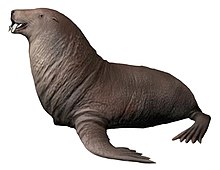Gomphotaria
Appearance
| Gomphotaria Temporal range: Late Miocene,
| |
|---|---|

| |
| Restoration of Gomphotaria pugnax | |
| Scientific classification | |
| Domain: | Eukaryota |
| Kingdom: | Animalia |
| Phylum: | Chordata |
| Class: | Mammalia |
| Order: | Carnivora |
| Clade: | Pinnipedia |
| Family: | Odobenidae |
| Genus: | †Gomphotaria Barnes & Rashke, 1991 |
| Type species | |
| Gomphotaria pugnax Barnes & Rashke, 1991[1]
| |

Gomphotaria pugnax was a species of very large shellfish-eating dusignathine walrus[1] found along the coast of what is now California, during the late Miocene. It had four tusks, with one pair in the lower and upper jaws, and according to wear on the tusks, G. pugnax hammered shellfish open, rather than simply sucking them out of their shells as do modern walruses. In terms of the postcranial skeleton, Gomphotaria and other dusignathine walruses were built more like sea lions than modern walrus. Gomphotaria is a prime example of the extreme diversity that walruses once exhibited.
References
Wikispecies has information related to Gomphotaria.
Wikimedia Commons has media related to Gomphotaria.




